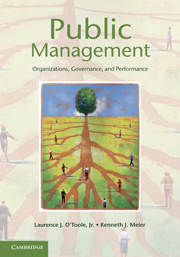Book contents
- Frontmatter
- Contents
- List of figures
- List of tables
- Preface
- 1 Public management and performance: an evidence-based perspective
- 2 A model of public management and a source of evidence
- 3 Public management in interdependent settings: networks, managerial networking, and performance
- 4 Managerial quality and performance
- 5 Internal management and performance: stability, human resources, and decision making
- 6 Nonlinearities in public management: the roles of managerial capacity and organizational buffering
- 7 Public management in intergovernmental networks: matching structural networks and managerial networking
- 8 Public management and performance: what we know, and what we need to know
- Glossary
- References
- Index
2 - A model of public management and a source of evidence
Published online by Cambridge University Press: 05 June 2012
- Frontmatter
- Contents
- List of figures
- List of tables
- Preface
- 1 Public management and performance: an evidence-based perspective
- 2 A model of public management and a source of evidence
- 3 Public management in interdependent settings: networks, managerial networking, and performance
- 4 Managerial quality and performance
- 5 Internal management and performance: stability, human resources, and decision making
- 6 Nonlinearities in public management: the roles of managerial capacity and organizational buffering
- 7 Public management in intergovernmental networks: matching structural networks and managerial networking
- 8 Public management and performance: what we know, and what we need to know
- Glossary
- References
- Index
Summary
How do organizations and governance systems shape performance, and how do managers influence what happens? In this chapter, we develop a model to answer these questions and guide our exploration of the real world of management. We model two distinct levels: the organizational and the network. While much of the empirical work developed later in this book focuses on how management makes a difference on the organizational level, many programs are implemented via complex networks that combine the efforts of multiple organizations. This structural variance means that it is important to discuss management in the context of the broader patterns of governance now evident in many public programs.
Since much of the rest of the book explores these theoretical ideas empirically, we also discuss data and data requirements. We start with an assessment of the type of data needed to test our theories. We then discuss the Texas schools data set, our primary data set, and its relative strengths and weaknesses. We then note other data sets used in various work in the public management–performance research agenda, including in some of our own studies. Several of these other data sets have enabled researchers to explore in other venues some of the important questions examined in this book, and we refer to a number of such studies in later chapters. Finally, we provide a specific discussion of performance measures for the Texas schools data set as well as the production function used in subsequent analyses.
- Type
- Chapter
- Information
- Public ManagementOrganizations, Governance, and Performance, pp. 23 - 54Publisher: Cambridge University PressPrint publication year: 2011



